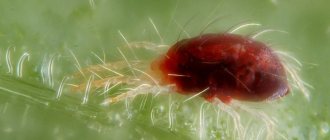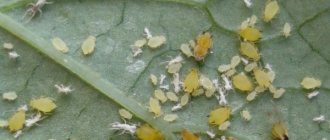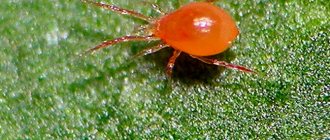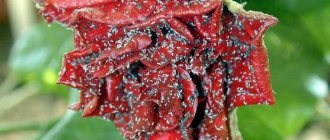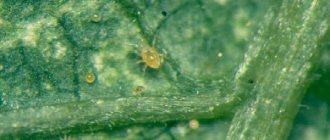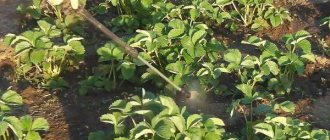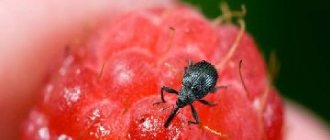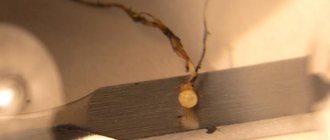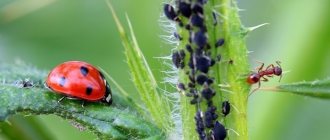Description of the pest
Aphids are small insects of the order Hemiptera, causing significant damage to gardeners.
There are a huge variety of pest species: today about 4 thousand of them are known (a quarter of them live in Europe), with new species being added to the list every year. All varieties of insects feed on plant juices, and most of them are also carriers of viral diseases dangerous to plants. Aphids have microscopic sizes - from 0.5 to 2 mm. in length. Its soft, egg-shaped body is very easy to crush, since the insect does not have hard covers. Adults are green or black, with long legs, winged and wingless. Those insects that do not have wings move through plants very slowly, while winged aphids can easily move long distances.
The pest is distinguished by its ability to reproduce very quickly. Each female lays up to 100 eggs in the fall, from which, with the arrival of spring, new individuals develop, which in just a couple of weeks themselves become ready for reproduction. In one season, one female can increase the pest colony by 15-20 thousand new individuals.
Why are aphids dangerous?
It would seem that such a small insect, but how many problems it can cause to a gardener! There are several thousand species of aphids, but no matter which one you have on your property, it will begin to quickly and systematically destroy the harvest of fruits, vegetables, and herbs, and aphids do not disdain the flowers in the garden.
You will easily understand that something is wrong with your plants, because deformed buds, twisted and limp leaves, spots formed on them and other damage called galls will tell you about it. If you notice suspiciously active ants in your area, then this is another sign of the presence of aphids in the garden.
The thing is that ants are attracted to droplets of sweet liquid - the so-called honeydew, secreted by these pests. They feed on this sweet substance, so they protect aphid colonies, “graze” them, and can even take females with them to the anthill for the winter. Therefore, you need to get rid of ants, and I’ll tell you now how to get rid of aphids on strawberries.
Prevention of aphids
Strawberries damaged by aphids
To prevent aphids from appearing on strawberry bushes, you should follow some rules:
- before planting purchased bushes, carefully inspect each one for laid aphid eggs, which may be located at the bottom of the stems;
- strawberry bushes are planted in the garden taking into account sufficient space and lighting;
- regularly pick off damaged and deformed leaves; it is better to remove very diseased bushes;
- plant umbrella plants (parsley, dill) in the rows to attract insects that will help remove aphids, since they feed on them: ladybugs, lacewings, earwigs and hoverflies;
- To repel pests, calendula, mint, thyme, chamomile, garlic or onions are planted around strawberries.
The health of the plants and regular care are important: loosening and mulching the soil, watering, fertilizing with potassium and phosphorus, since healthy strawberry bushes have better resistance to pests.
source
Aphids rarely attack strawberries, but when there is an abundance of the pest on the site, such cases occur. It is necessary to fight aphids quickly, otherwise you may not even dream of a harvest. Aphids are not mole crickets, which seem to harm garden strawberries, but seem to help by destroying beetles. When it comes to aphids, you need to be uncompromising - destroy them, including using chemicals.
Features and signs of aphids
The pest is ovoid in shape, slightly elongated, with long legs. This insect is white and rather slow.
In nature, there is also a species that has wings. This species is considered the most dangerous, as they reproduce very quickly and constantly move. Most often, larvae can be found on branches, flowers, and leaves on the reverse side.
Note! As a rule, ants settle near the affected plants. Be very vigilant, because timely detection of a pest on a plant can greatly facilitate the fight against it.
We have already written about how to get rid of ants on currants.
You should be alert to some signs of the presence of this pest:
- Foreign smell. The bushes will have a strong sweet aroma, which is completely unusual for them.
- The foliage becomes soft and weak, and also curls into a tube.
- The green color of the plant changes its shade.
- The bushes on top are modified.
- There is the presence of honeydew.
You can look at a photo of the aphid to be sure to recognize it later. The general condition of the strawberry bush will be very painful.
Against the background of pest damage, she may also be sick with infections. This can be confirmed by galls that appear on the leaves. This can be recognized by the dark coating on the plant.
This pest is a real disaster for the garden. After all, it greatly damages the plant:
- Takes the juice. Because of this, the plant begins to wither and dry out.
- Changes the shape of the buds.
- Makes shoots uneven and thin.
- Deprives the plant of growth.
If you see aphids, how to get rid of them as quickly as possible should be your first priority. After all, the berries will no longer be able to fully ripen; they will also become significantly smaller in size and completely tasteless and watery.
If damaged by these insects, strawberries cannot survive the winter. Cold weather can destroy the plant. Aphids are dangerous because they absorb juices from the plant; due to their lack, it becomes lethargic and weak. This means that the bush will not be able to resist diseases.
When aphids attack strawberries
The most favorable conditions for the appearance and rapid reproduction of aphids are dry, warm weather and dense plantings. If there is little rain in the summer, you should be especially careful about the condition of the strawberry bushes: by identifying the pest in a timely manner, it will be much easier to defeat it.
Aphids are omnivorous; they can settle on any crop growing on the site. The insect easily moves from plant to plant and is capable of “capturing” large areas if no measures are taken.
Black ants can bring pests into garden beds. They deliberately distribute female aphids to cultivated areas in order to create new colonies of these insects to obtain sweet honeydew from them.
Types of aphids and harm to plants
Aphids are insects of the order Hemiptera, of which there are up to 4 thousand species in the world, including almost 1 thousand in European countries. These small bugs, green or black, 0.5-2 mm in size, can exist in wingless and winged form. Their rapid reproduction occurs due to the fact that a once fertilized female is capable of producing offspring of 150 larvae every 2 weeks throughout the warm season.
Aphids settle on the lower parts of leaves, stems and buds of various vegetable and garden crops, including strawberries and berries. Ants often breed it, setting up their colonies nearby, and for food they run to the “farm” and drink the sweet honeydew secreted by aphids. This liquid sticks to the leaves, reducing their respiration, which contributes to the appearance of harmful fungal diseases (sooty fungus).
Aphids on strawberries
Aphids feed on plant sap, sucking it out of buds, flowers, leaves and stems, which begin to curl, deform and dry out, fruits stop developing and do not ripen, and flowers fade. Black aphids are especially dangerous on strawberries due to their rapid reproduction. If the damage is severe, the weakened plant may die in winter.
On a note!
Insects live in large groups on the underside of leaves, near growing points, on flowers and buds. To verify the presence of aphids, just turn over the leaves of strawberries and see a massive accumulation of small green or black bugs. After which you will have to think about what to treat the plants with in order to destroy pests.
Strawberry whitefly
This is one of the smallest pests that damages strawberry bushes. The size of the whitefly is slightly more than 1 mm and in appearance it looks like a small butterfly. The pest damages the lower leaves of the strawberry and lays its eggs there. As whiteflies damage the strawberry leaves, they begin to curl and turn yellow. Often fungal diseases and characteristic discharge appear on the bushes.
Strawberry pest larvae form small holes on the leaves. In one season, a whitefly can produce about 4 offspring.
The most common folk remedy for strawberry diseases with strawberry whitefly damage is planting plants in well-lit areas, since the pest is afraid of sunlight. In addition, cucumbers and cabbage should not be planted near strawberries, as these crops attract miniature butterflies.
Not everyone knows how to protect strawberries from pests using folk remedies. For this purpose, decoctions and infusions of garlic and chamomile inflorescences are used.
How to fight aphids on strawberries?
There are a variety of ways and methods, both traditional and folk. The first involve the use of chemicals - insecticides, but they cannot be used on already set berries, especially before harvesting the fruits, although they guarantee a lasting positive result after a single application.
Biological agents that are not poisons can help. They contain bacteria of beneficial microorganisms, the waste products of which kill aphids. They influence pests through the juice of the same strawberries. Bacteria enter plants during watering or spraying.
The best biologically active preparations for strawberries are Fitoverm, Aktara, Iskra, Fitosporin and Inta-vir.
More aggressive preparations cannot be used for spraying during flowering, as this will impair pollination due to the destruction of pollinating insects. If strawberry pests take you by surprise, remain calm, because you can always use one, or even several folk remedies for aphids.
Here are some of them:
- Dilute 1 tbsp in one liter of plain clean water. l. liquid or laundry soap and use for spraying plants.
- Chop fresh tomato leaves and soak overnight in water in a ratio of 4 kg per 10 liters of liquid. Some people immediately strain the infusion in the morning, dilute it with a small amount of water and use it for processing, but you can treat strawberries against aphids if you immediately boil the leaves in water for 30 minutes, cool, strain, dilute with water in a ratio of 1:3 and add 40 g of soap.
- Gardeners often use garlic infusion. Chop half the head, add 4 liters of plain water and put it in a warm place for 5 days. After straining, dilute 60 ml of tincture in one bucket of water, add 50 g of soap and use in the spring for processing.
- Aphids on strawberries will disappear if you also prepare an infusion, but this time with tobacco. Pour 400 g of tobacco leaves into 10 liters of plain clean water, and after 48 hours filter, dilute with the same amount of water and add 40 g of soap.
- Vinegar solution is also effective against insects. Dilute 20 ml of this product in 10 liters of water and use it to treat strawberry or strawberry bushes against aphids.
Folk remedies to combat aphids
Most often, aphids settle on strawberry bushes during flowering or when setting berries. You can treat strawberries against aphids during fruiting only with folk remedies: infusions or decoctions; some gardeners successfully use washing off pests with a strong stream from a hose.
Methods for controlling aphids on strawberries
During this period, folk methods of combating aphids are suitable:
- Sprinkling the bushes with dry powder of tobacco, shag mixed with ash or slaked lime in equal proportions.
- Treatment with wood ash: sprinkle dry between rows or dilute 200 g of ash in 10 liters of water with the addition of 100 g of soap and spray.
- Infusion of crushed potato tops (1.2 kg) in a bucket of warm water, leave for 3-4 hours, then add 40 g of laundry or green soap. It is necessary to spray strawberries, paying more attention to the underside of the leaves.
- Pour 4 kg of green tomato tops into 10 liters of water and boil for 30 minutes. and strain. Before use, dilute in a ratio of 1:3 with the addition of 40 g of soap.
- An infusion of onion peels is prepared as follows: pour 0.5 buckets of onion peels with boiling water, leave for 24 hours, strain. Before spraying, the solution is diluted in a ratio of 1:2.
- A solution of 20 ml table vinegar per 10 liters of water is used for spraying bushes.
- 400 g of tobacco leaves are poured into 10 liters, left for 2 days, filtered and the same amount of water and 40 g of soap are added.
- Grind half a head of garlic, add 4 liters of water, leave in a warm place for 5 days, strain. To remove aphids, make a solution of 60 g of tincture per bucket, 50 g of soap and spray the plants.
- Sprinkle a decoction of chamomile, marigold and yarrow on strawberries, which will effectively repel aphids.
How to determine the presence of aphids
These insects can be white, black, greenish and even pink in color. They settle in the lower part of the stem, closer to the soil, and also on the back of the leaves. They crawl into secluded places in flowers and ovaries, can crawl along petioles, and then migrate to other crops.
Aphids can be detected visually by the following external signs:
- the leaves gradually fade, lose their elasticity and shape;
- after watering, the leaves do not recover and continue to lose strength;
- A large colony of ants was discovered next to the strawberry bed;
- on the plant itself there is a sticky, viscous liquid that has a sweet taste;
- the bushes grow slowly, their tops are deformed;
- Foreign formations appear on the stems.
Affected plants look much worse than healthy ones and lose growth rates. Therefore, the strawberry bed must be inspected regularly in order to destroy pests at the colony nascent stage.
Signs of plant damage
In order not to miss the moment of infection, you need to know what aphid-infested strawberries look like. This will allow you to quickly respond to insect attacks and repel their attacks.
Escapes
On external examination of plant stems, changes can be detected at their tops. Atypical formations can be found on green shoots of strawberries. The appearance of drops of sticky liquid is also a sign of aphid infestation. The berry bushes look weak and sick. Even watering doesn't help.
buds
When insects attack the flowers of a plant, it begins to deform. It dries out and the growth and ripening of fruits stops. Black aphids are especially dangerous. It multiplies quickly, which leads to the death of bushes in winter.
Underside of leaves
You can detect the appearance of pests if you take a good look at the leaf of the plant. Aphid colonies settle on its lower part. Honeydew, secreted by insects, sticks to strawberry leaves and prevents them from “breathing.” The plant develops fungal diseases. Affected leaves wither and curl. Later they die and fall off.
This reduces the oxygen supply to strawberries and leads to metabolic disorders in the plant. It stops blooming and developing. Then he dies.
Smell
Another sign of strawberry disease is the smell, or rather, its absence. The affected plant loses the aroma inherent in healthy strawberry shoots and fruits.
What harm does strawberries cause, signs of aphid damage
Aphids, settling on strawberries, suck all the juices from their tissues. Bushes weakened by the pest slow down in growth, lose immunity and vitality. Such plants are no longer able to fully bear fruit, and if left untreated, they simply will not cope with the invasion of dangerous insects and will die quite quickly.
The presence of aphids on strawberries is indicated by the following signs:
The pest is easy to detect by simply examining strawberry bushes: aphids form numerous colonies on the shoots and leaves of plants.
Chemicals
In addition to “folk art”, agrochemicals are also used in the fight against aphids. Let's get acquainted with the most commonly used means.
To prevent the berries from accumulating harmful substances, the first treatment of strawberries is carried out in the spring before the flowering stage. In summer, the berries are sprayed no later than 20 days before the strawberries ripen.
Aktara
This is what a bag of “real” Ankara from SYNGENTA looks like, the authenticity of which is confirmed by a holographic sticker.
The active ingredient is thiamethoxam . The effect of the drug does not depend on the ambient temperature. Once on the plant during treatment, the product is absorbed and moves only through the vascular system of the leaves, without penetrating into the fruit.
The effect lasts up to 100 days. For treatment, 1.4 g of the drug is dissolved in 10 liters of water and this volume is enough to spray one hundred square meters.
Spark
This remedy acts on aphids by the enteric contact method. A protective mixture is prepared from half a tablet of the drug and water. Its quantity is adjusted to 5 liters. If after the first treatment of strawberries the aphids have not disappeared, spraying is repeated after 21 days.
Inta-vir
For 10 liters of water – 1 tablet of the drug. It is prohibited to process plantations more than 3 times. This harms the plantings. You cannot use a protective agent during the flowering stage of strawberries.
Aliot
Aliot product based on karbofos against a complex of pests.
The active ingredient melathion is an organophosphorus compound.
The drug is highly effective, but the waiting period (21 days) does not allow its use before picking berries, as well as on remontant plantings.
The drug has contact, intestinal and fumigation effects.
To prepare a working solution, 10 ml of the drug is dissolved in 5 liters of water and one hundred square meters is processed.
Fufanon
Since 2012, it has been prohibited for use in household plots, but its full analogue “Aliot” is quite competitive.
Aktellik
Actellik penetrates the back of leaves and hard-to-reach places.
The drug is based on the organophosphorus substance primifos-methyl. Upon contact with an insect, it is absorbed and begins an immediate action, with death occurring within 1–3 hours.
When sprayed on a plant form, but without getting on an insect, the drug acts as an intestinal. The aphid sucks out the intercellular fluid with a poisonous beginning and immediately dies .
To treat a strawberry bed, you need to dilute 6 ml of the product in 5 liters of water, and this volume will be enough for one hundred berry plantings.
The effect of the drug lasts up to 8 days depending on the ambient temperature. The hotter it is, the faster the active substance decomposes.
Angio
Double action drug. One part destroys aphids, and the other prevents the reappearance of pests for 3 weeks. It is better to apply after harvesting. Working composition – 3.6 ml per 10 liters of liquid.
Biological preparations for aphids
Organic farming does not allow the use of chemicals, and there is a worthy alternative to them.
Vertimek
For maximum effectiveness, spraying with Vertimek is carried out in cloudy weather, in the morning or evening.
The active substance abamectin is a waste product of a microscopic fungus.
The contact effect is very short, since when sprayed it is quickly absorbed and penetrates the vascular system of the strawberry. But the intestinal action, when the aphid sucks out the cell fluid, lasts up to 7 days.
Once absorbed, the drug is unable to move throughout the plant, so it cannot pass into the berry. Elevated temperatures quickly decompose the product and after 7–10 days it is completely inactivated.
The drug is also convenient because aphids usually “sit” on the lower part of the leaf, which cannot be sprayed, and Vertimek, being absorbed even by the upper side of the leaf plate, is quite accessible for absorption by aphids .
To carry out the treatment, just dilute 10 ml in 5 liters of water and treat one hundred square meters of strawberries.
Fitoverm
Fitoverm does not lose effectiveness with repeated treatments, since insects do not develop resistance to its active components.
The basis of the drug aversectin-S. The effect of the drug becomes visible after 2-3 days, and acts as a contact and intestinal one. The manufacturer names the same numbers when indicating the waiting period, from the moment of processing to the moment of harvesting.
If the effectiveness of chemical preparations decreases with increasing air temperature, then when using this product it increases.
The protective property lasts for 20 days.
Lipidocide
Insecticide of biological origin Lepidocide is used to combat all leaf-eating pests.
A bacterial preparation containing a pathogen that infects aphids.
Does not accumulate in plant form and fruits. Treatment can be carried out at any phase of the growing season. At least 5 days must pass from the moment of processing to harvesting the berries. After 7–8 days, the treatment must be repeated.
Enterobacterin
The drug contains spores of very specific bacteria Bacillus thuringiensis, which have a pathogenic effect only on certain insects.
Enterobacterin and similar drugs have a minimal effect on the plant, but they act for only a few days and therefore require re-application after a week.
Penetrating into their intestines, the bacterium releases a toxin, which causes death. It is effective against a wide range of pests, but its effect does not last long, and 5-6 days after application it begins to decline rapidly. That is why the waiting period is only 5 days, however, it can be used at temperatures above 25 ᵒC.
The drug is effective, but requires re-treatment after 7-10 days.
“ Bitoxibacillin ”, “ Dendrbacillin ” drugs are completely similar to enterobacterin with the same active base, but are manufactured by different manufacturers.
For treatment, prepare a solution with 30–40 g of the drug per 10 liters of water. The product must be used within 2–3 hours after preparation.
Fighting with folk methods
Proven methods of fighting aphids on strawberry bushes using folk remedies are preferred by land owners, despite the creation of increasingly new, non-toxic chemicals.
Infusions
The use of mixtures and infusions that kill aphids is constantly expanding. A variety of improvised means are used. Strawberry plantings are sprayed with aqueous solutions. Their difference from household chemicals is their lack of toxicity.
Solution or mixtureCompositionManufacture and use
| Soap and soda mixture | Laundry soap - a quarter of a bar, 1 tbsp. spoon of soda ash, 1 liter of water | Grated soap is mixed with soda and water. Without a soap base, during precipitation, soda is quickly washed off from treated plants |
| Infusion of zest | 1 liter of water, half a liter jar of dry zest | Soak the crushed zest in a liter of water and let it brew for 24 hours. Boil the mixture for 10 minutes. and strain. Pour into a 10 liter bucket. To increase efficiency, add a tablespoon of liquid soap. |
| Horseradish infusion | Horseradish roots and leaves | Grind and fill the container you are using 1/3 full. Add boiling water to the top. Let it brew for 24 hours. |
| Hot pepper solution | 1-2 pods of hot pepper | Finely chop, pour boiling water. Leave for several hours. |
To fight aphids with folk remedies when planting strawberries in open ground, there are many other mixtures and solutions.
From onion skins
Chop 30-35g of onions, mix with peels and water. After 5 hours, add 5g of laundry soap into the container. Filter and get 1 liter of infusion.
Garlic
Turn the garlic into pulp. For 1 liter of boiling water you need a large head. Cool the liquid, pour 2 tsp into it. detergent. To improve the quality of the infusion, add 2 tbsp. l. sunflower or other oil.
In addition to the garlic solution, its cloves, arrows, and husks are also used. Ants that carry aphids cannot tolerate the smell of garlic. They leave, and the pests die.
Chopped garlic is laid out between the rows of strawberry plantings and applied in the form of a paste to infected bushes. Garlic arrows are also used. This protection is valid for up to 15 days.
From wood ash
A method that has been proven over the years and is “killer” for aphids. Mix 5 liters of water and ash. You will need 1 glass. The mixture is infused for 12 hours. Next, the areas affected by aphids are sprayed.
pharmaceutical camomile
For chamomile solution you will need 100 g of pharmaceutical mixture. Fill it with 1 liter of boiling water and wait 12 hours. 4 g of soap will improve the quality of the mixture. The solution is diluted in a ratio of 1-3. The infusion is ready.
Uses of marigolds
Marigolds are bright and beautiful flowers. Summer residents and owners of garden plots use them to decorate their territory and as a powerful weapon against insects. Their aroma drives away pests from ripening fruits.
The marigold solution kills aphids. It is prepared from crushed parts of flowers, half-filling a 10-liter bucket with them. Fill with water at a temperature of 60 and let stand for 48 hours. Strain and place 40 g of laundry soap into the mixture. Treat the strawberry planting with a spray bottle. The greatest effect is achieved after 3-4 sprayings.
Tobacco
The solution is made from crushed tobacco. It is obtained from leaves or cigarette butts. They also use shag. A glass of mixture requires 5 liters of boiling water. After a day of settling, the solution is filtered. It's quite strong. There is no need to spray the strawberry plantation with it before fruiting. It is allowed to pick berries only after 7 days after using the mixture.
Tomato and potato tops
Fill half a 3-liter container with chopped nightshade tops. Fill with boiling water and leave for a day. The infusion is supplemented with 1 tbsp. spoon of soap or washing powder. Stir the solution and process the strawberries.
In the video below, the author talks about how he fights aphids, thrips and mites on his strawberries.
Vinegar
The use of acetic acid to treat strawberries is also a commonly used method of killing aphids. Protective solutions vary due to the concentration of the acid. Apple and table cider vinegar are used, or vinegar essence can be used. Some recipes for vinegar mixtures:
- 9% table vinegar - dilute 1 teaspoon in 1 liter of water;
- for 1 liter of liquid – 1 tbsp. spoon of apple cider vinegar;
- 1-2 tablespoons of essence per 10 liters of water;
- So that the solution “clings” better to the leaves and stems of strawberries, soap-based products are added to it. 3 tbsp. spoons per 10 liters of mixture are quite enough.
Garlic
In addition to the garlic solution, its cloves, arrows, and husks are also used. Ants that carry aphids cannot tolerate the smell of garlic. They leave, and the pests die. Chopped garlic is laid out between the rows of strawberry plantings and applied in the form of a paste to infected bushes. Garlic arrows are also used. This protection is valid for up to 15 days.
Soap solution
Making a soap solution requires 1 liter of water and 4-5 tablespoons of soap base. It is better to use household chemicals without a strong aroma. It may attract insects.
Tar soap (its smell) has a stronger effect on insects. 100 g per 10 liters of water is enough.
Tobacco and tobacco dust
The solution is made from crushed tobacco. It is obtained from leaves or cigarette butts. They also use shag. A glass of mixture requires 5 liters of boiling water. After a day of settling, the solution is filtered. It's quite strong. There is no need to spray the strawberry plantation with it before fruiting. It is allowed to pick berries only after 7 days after using the mixture.
Marigold
Marigolds are bright and beautiful flowers. Summer residents and owners of garden plots use them to decorate their territory and as a powerful weapon against insects. Their aroma drives away pests from ripening fruits.
The marigold solution kills aphids. It is prepared from crushed parts of flowers, half-filling a 10-liter bucket with them. Fill with water at a temperature of 60 and let stand for 48 hours. Strain and place 40 g of laundry soap into the mixture.
Treat the strawberry planting with a spray bottle.
The greatest effect is achieved after 3-4 sprayings.
Preparing strawberries for winter
In order for a plant, slightly weakened by the attack of these pests, to survive the winter, you need to follow a few simple rules:
- Apply complex fertilizing.
- Immediately after harvesting, loosen the soil. Do not disturb the soil until winter sets in.
- Before the onset of winter, cut off diseased leaves, remove fallen leaves, and pull out weeds.
- Pull out very weak bushes and burn them.
- Mulch the ground around the bushes.
- In September-October, water everything with a weak solution of potassium permanganate, which will kill off the remaining parasite eggs.
Prevention against mass pest attacks
Preventive measures are given paramount importance; they can prevent the appearance of a dangerous pest without using substances dangerous to the living world.
- You need to carefully examine the purchased strawberry bushes. Even if they were purchased at a garden center, this does not guarantee that the little pest could not “lurk” in the foliage.
- Plant umbrella plants next to the garden bed or along the plantation: dill, fennel, parsley. This will attract those who like to eat aphids - hoverflies.
- If you place flower pots with wood shavings nearby for earwigs, they will readily feed on aphids.
- Feeders and birdhouses are boring for populating birds. They eat aphids en masse and feed the chicks with them.
- Nasturtium, lavender and thyme, planted in small islands at a distance, can repel dangerous pests.
- Feeding strawberries is important to keep the bushes healthy and strong. Aphids prefer weakened plants.
- There is no need to plant bushes close to each other. They will lack light and nutrition. In addition, caring for such plants is inconvenient.
- A sufficient amount of light, good watering, loosening and mulching of the soil are agricultural techniques that will help strawberries grow strong.
Tip #1. Use chemicals only as a last resort, because not only pests will die, but also their natural enemies.
With proper agricultural technology and the use of folk remedies at the first signs of infection, strawberry bushes will be strong and healthy
Medvedka
This is one of the most dangerous pests in any garden plot, as it eats the rhizomes of not only strawberries, but also most other crops. The size of the parasite reaches 6 cm, and sometimes more; it lays eggs deep underground and it is simply impossible to find them. The larvae feed on the roots, just like the adult, as a result of which the bushes begin to dry out and the plant dies.
In the process of parasitizing a plant by mole crickets, concomitant strawberry diseases arise and the fight against them with folk remedies is not always effective, so gardening professionals recommend preventing the occurrence of mole crickets rather than getting rid of them later.
You can prevent the occurrence of a large number of the parasite by luring birds to the plantation, which eat both adults and their larvae.
In addition, folk remedies for strawberry pests, in our case mole crickets, involve setting traps. To do this, a jar with a small amount of honey is buried in the ground, covered with leaves or straw on top. Once caught in such a trap, the mole cricket cannot get out of it and dies.
Traditional methods of combating strawberry diseases resulting from mole cricket damage include planting plants such as marigolds, calendula or garlic near the strawberry plantation.
You can catch a mole cricket by pouring a solution of laundry soap into its holes, and the pest comes out.
Prevention
The main defenders of aphids are ants; first of all, it is worth getting rid of their colonies, which in a short time can surround a fairly large strawberry plantation. No matter how cruel it may sound towards hardworking insects, their anthills need to be dug up, if this does not help, and they rebuild them again, then during the next digging you will need to add ash, wormwood, salt or lime to the soil, you can also pour sunflower oil there.
It may also be useful for you to learn about what aphids look like on beets and what control methods can be used.
To protect strawberries from this scourge, you need to plant garden crops around them that will be more attractive to aphids, such as nasturtium, mallow, cosmos or trees (linden or viburnum). It will also be useful to learn about how aphids are treated on viburnum.
The following preventive measures will help you avoid aphid infestations:
- Before planting, carefully inspect the strawberry seedlings, even if they were purchased in a trusted store or taken from a neighboring bed. In this case, it is better to play it safe than to fight aphids later.
- You should arrange attractive places on the site near the strawberries . For example, install pots with wood shavings that will be designated for earwigs.
- Plant umbrella plants along the area with strawberries: parsley (by following the link you can learn how to grow root parsley) , dill, fennel, which attract hoverflies with their smell . These insects feed on aphids and will save strawberries from their invasion.
- Aphids most often attack weakened plants; to prevent this from happening, you need to feed them in a timely manner.
- For good growth, strawberries need regular loosening, watering and mulching of the soil, then its bushes grow strong.
- Birds are also greedy for aphids; it is worth organizing several feeders or birdhouses on your site so that they become frequent guests on the site, and at the same time protect the plants from annoying insects.
- When planting strawberry bushes, it is important to maintain a distance between them so that the foliage does not touch each other.
- It is advisable to plant onions between the strawberries (You may also find it useful to know whether it is possible to plant onions after carrots) or garlic; some gardeners plant it directly between the strawberries; this greenery can repel aphids with its smell.
The video shows preventive measures:
Strawberry diseases and treatment
Pests cause a lot of different problems to the garden:
- the risk of developing various diseases increases;
- frost resistance decreases (does not tolerate winter well and may die);
- the tangles weaken;
- the plant dies.
To prevent this from happening, every gardener, even an amateur, must, before planting a plant, take care of its further prosperity and protect the strawberries from the effects of harmful factors on them.
Very often, gardeners use traditional medicine to combat various insects, which do not contain substances harmful to the human body. But before we begin to consider folk remedies, it is necessary to deal with the parasites that “attack” strawberries, there are many of them and each individual case requires its own approach.
Strawberry pests:
- weevil;
- aphid;
- strawberry whitefly;
- mite;
- mole cricket;
- slugs
Let's take a closer look at each type of pest, how they form, develop and, of course, how to fight them using traditional methods.
conclusions
The choice of preparations for treating strawberry beds against aphids is large.
The plant can and should be helped, but this must be done in a timely manner, without waiting until the insects have already caused irreversible damage. Constant monitoring of the state of the crop will allow you to identify the insect in time and provide assistance with the means of protection that can be used in a certain phase of the growing season.
Sources
- https://sort-klubnika.ru/bolezni-i-vrediteli/kak-izbavitsya-ot-tli-na-klubnike
- https://sovusadba.ru/vrediteli-i-bolezni/sposoby-borby-s-tlej-na-klubnike.html
- https://newogorod.ru/klubnika/kak-spasti-klubniku-ot-poyavleniya-tli
- https://notklop.ru/tlya/izbavitsya-ot-tli/tlya-na-klubnike/
- https://love-dacha.ru/tlya-na-zemlyanike-kak-borot-sya-narodnyye-sredstva/
- https://GdeKlop.ru/tlya/na-klubnike-v-otkrytom-grunte/
- https://agroved.org/tlya-na-klubnike/
- https://frukti-yagodi.ru/tlya-atakuet-klubniku-metody-borby/
- https://alt-zem.org/frukty-i-yagody/metody-bor-by-s-tley-na-klubnike.html
- https://GidFermer.com/sadovodstvo/borba-s-vreditelyami/tlya-na-klubnike-kak-borotsya.html
[collapse]
